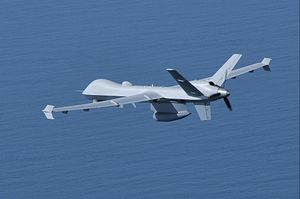India is continuing to press the U.S. government to approve the possible purchase of 22 multi-mission Predator Guardian unmanned patrol aircraft from U.S. defense contractor General Atomics as Indian Prime Minister Narendra Modi is set to meet U.S. President Donald Trump in Washington D.C. later this month, Reuters reports.
India sees progress on the drone sales as a key test to India-U.S. defense cooperation under the new U.S. presidential administration. “We are trying to move it to the top of the agenda as a deliverable, this is something that can happen before all the other items,” one Indian official told Reuters.
India first dispatched a letter of request to U.S. authorities in which it expressed its intention to purchase the unmanned aerial vehicles (UAVs) to begin the Foreign Military Sales (FMS) process in June 2016. As of now, the U.S. government has not issued a letter of acceptance to greenlight detailed sales negotiations.
The Indian government has expressed interest in purchasing an unarmed naval variant of the Predator (UAV) already prior to 2015. However, the United States rejected India’s request on the grounds that the country was neither member of the Missile Technology Control Regime (MTCR) nor did it enjoy Major Defense Partner (MDP) status.
In June 2016, India became a member of MTRC and was finally granted MDP status in the same month.
“The designation as a ‘Major Defense Partner’ is a status unique to India and institutionalizes the progress made to facilitate defense trade and technology sharing with India to a level at par with that of the United States’ closest allies and partners (….)” a December 2016 joint U.S.-India statement by then U.S. Defense Secretary Ash Carter and his Indian counterpart Manohar Parrikar said.
Following the amendment of U.S. export control laws, MDP status “creates a presumption of approval” for the Indian government seeking to import U.S. military hardware (excepting weapons of mass destruction related goods). Should the U.S. government approve the purchase of the drones it would constitute the first purchase by a country that is not a member of the NATO alliance. As I explained in June 2016:
With the new UAVs, India seeks to protect its maritime assets, in particular in the Indian Ocean, and detect intrusions on a real-time basis. Next to the threat of terrorism emerging from the maritime domain, India has been in particular concerned about the growing Chinese naval presence in the Indian Ocean.
According to General Atomics, the Predator Guardian UAV, a variant of the Predator B, can be used for wide-area, long-endurance maritime intelligence, surveillance and reconnaissance missions. It can stay in the air for up to 27 hours and can fly at maximum altitude of 50,000 feet (15,240 meters).
“Twice as fast as Predator, the aircraft carries 500 percent more payload and has nine times the horsepower. It provides a long-endurance, persistent surveillance/strike capability for the war fighter,” the General Atomics company website states.
In November 2015, India has also expressed interest in procuring armed Predator Avenger drones.

































